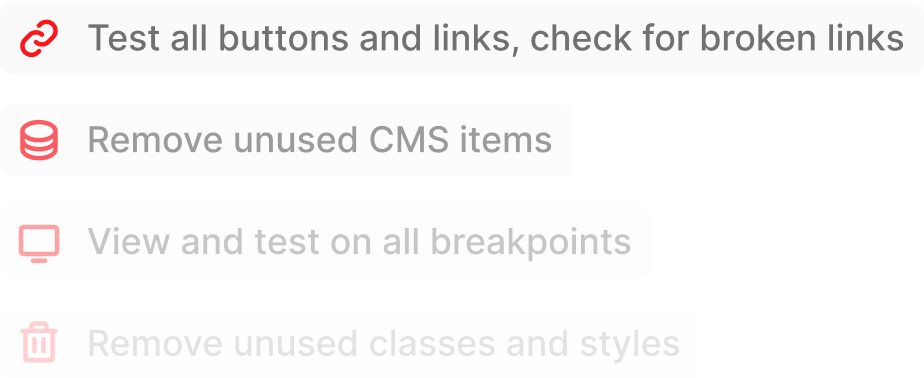We’ve been thinking about what separates a good Webflow site from a great Webflow site. There are so many incredible Webflow-built projects around – but what is it that makes them so remarkable?
What elements do you need in a great Webflow site? Let’s find out 👇
1. Scalability
One of the most crucial aspects of web development is not only envisioning the site's immediate requirements but also thinking about its potential for expansion and accommodating the needs of rapidly growing teams. The aim here is to prioritize building websites that not only cater to the present demands but also facilitate seamless scalability for future growth.
➡️ There are several strategies you can leverage to ensure the long-term manageability and comprehensibility of your Webflow website.
Client-friendly class naming systems
One of the key approaches we embrace is the creation of client-friendly class naming systems. This empowers those unfamiliar with the website's intricacies to easily navigate and understand its components.
This systematic approach not only simplifies the onboarding process for new team members but also enhances collaboration with external stakeholders. The overall aim is to make it as easy as possible to update and scale your website as it grows.
CMS structures
Another strategy is to lay a strong foundation by implementing easy-to-manage Content Management System (CMS) structures. A well-designed CMS framework enables efficient content updates, modifications, and additions, allowing teams to seamlessly adapt and evolve the website as their needs evolve.
👉 This is to ensure that websites can keep pace with your changing requirements.
2. Accessibility
Ensuring the accessibility of websites is a fundamental principle that separates good from great Webflow sites. Websites should be designed and built to be useful and inclusive for as many people as possible.
Accessibility goes beyond simply adding alternative text (alt tags) to images though. It encompasses a broader perspective that means we as developers need to think about the user interface (UI) and visual design to fully enhance accessibility.
➡️ Addressing accessibility concerns requires a holistic approach that considers the diverse needs of individuals with different abilities. It entails assessing the website's structure, functionality, and design elements to identify potential barriers and proactively implement solutions.
💡 One tip here is to incorporate accessibility from the outset of a project to design with intention and create websites that cater to a wider audience. This involves leveraging best practices such as color contrast optimization, intuitive navigation, clear typography, and proper heading hierarchy.
Additionally, it’s a good idea to always strive to adhere to web accessibility standards, such as WCAG (Web Content Accessibility Guidelines), to ensure our websites meet recognized industry benchmarks.
3. Mobility (responsiveness)
Mobile accessibility is hugely important in a world where a substantial portion of web traffic originates from mobile devices. All Webflow developers should consider creating websites that deliver an exceptional experience on smartphones and tablets.
In the not-so-distant past, the focus was on desktop design and development, while mobile responsiveness was an afterthought. Mobile usage is growing exponentially, so this shift in user behavior needs to be addressed proactively.
To achieve this, Webflow developers need to have a mobile-first mindset. Rather than treating mobile optimization as a secondary consideration, we need to place equal significance on ensuring that websites are just as functional, engaging, and visually appealing on mobile devices as on desktop computers.
Our mobile-first approach here at Hedrick entails prioritizing developing responsive designs that automatically adapt to different screen sizes and orientations. We meticulously craft layouts, typography, and interactive elements to ensure they are optimized for touch-based interactions and smaller screens.
Additionally, we leverage technologies and techniques that enhance performance and loading speed on mobile devices, such as image optimization and efficient code implementation.
FAQs – Frequently Asked Questions
How can I find inspiration for website design?
When seeking inspiration for website design, it's essential to explore a wide range of sources. Browse through curated collections of award-winning websites, follow design blogs and communities, and immerse yourself in the latest design trends. By studying successful websites across various industries, you can gather ideas, analyze design techniques, and spark your creativity to craft unique and compelling designs.
Can you provide some examples of websites built with Webflow?
Webflow has empowered countless individuals and businesses to create impressive websites. Check out these inspiring examples of websites built with Webflow, ranging from professional portfolios to corporate websites and online stores. These examples demonstrate the versatility and flexibility of Webflow as a platform, showcasing its ability to bring diverse design visions to life.
How can a web designer create an impactful user experience?
Creating an impactful user experience requires a web designer to consider various factors. This includes understanding the target audience, conducting user research, creating intuitive navigation, optimizing website performance, ensuring mobile responsiveness, implementing effective calls-to-action, and applying visual hierarchy principles. By focusing on user needs and preferences, a web designer can craft a memorable and engaging experience that delights and converts visitors.
What are the advantages of using Webflow as a website builder?
Webflow offers numerous advantages as a website builder, empowering designers and developers alike. Its intuitive visual interface allows for effortless design customization without the need for coding. With Webflow, you can create responsive and mobile-friendly websites, access a wide range of pre-designed templates, optimize your site for search engines, and seamlessly collaborate with team members. The platform's flexibility and robust features make it a powerful tool for bringing your design vision to life.
Are there any website templates available for Webflow?
Webflow offers a vast collection of professionally designed website templates that cater to various industries and purposes. These templates provide a head start in the website creation process, offering pre-built layouts, components, and styles that you can customize to match your brand and content. Whether you're creating a personal portfolio, a business website, or an e-commerce store, Webflow's templates save you time and effort while maintaining design quality and responsiveness.
What factors contribute to an effective landing page design?
Effective landing page design revolves around capturing visitors' attention and compelling them to take a desired action. Key factors include a clear and concise value proposition, compelling headline and subheadings, strategically placed call-to-action buttons, persuasive copywriting, visually appealing graphics or images, trust signals such as testimonials or social proof, and a clean and uncluttered layout. By optimizing these elements, you can create landing pages that drive conversions and achieve your business goals.
What are the key characteristics of the best website designs?
The best website designs exhibit a harmonious combination of aesthetics, functionality, and user experience. They feature visually appealing layouts, intuitive navigation, fast loading times, mobile responsiveness, compelling content, and seamless interactions. These designs effectively communicate the brand's message, engage visitors, and drive conversions.
How can I find inspiration for my Webflow website design?
If you're seeking webflow website inspiration, you can explore various sources. Visit design galleries and platforms dedicated to showcasing Webflow websites, follow design blogs and social media accounts that feature Webflow inspiration, and participate in Webflow design communities. These platforms offer a wealth of design ideas and insights from talented designers.
Can you provide some examples of good website design?
Absolutely! Explore these good website design examples that showcase effective use of color, typography, layout, and imagery. These websites exhibit clear navigation, well-structured content, attention to detail, and a seamless user experience. They serve as benchmarks for achieving excellence in website design.
How can I assess if a website qualifies as a good website?
Evaluating whether a website qualifies as a good website involves considering factors such as design aesthetics, user experience, functionality, relevance, and performance. A good website should have a visually appealing and cohesive design, intuitive navigation, well-structured content, fast loading speeds, mobile responsiveness, and effective calls-to-action. It should effectively meet the needs of its target audience and provide a positive browsing experience.
Related Articles
Read more
Read more
Read more
Hire Hedrick, Your Webflow Sidekick
Whether it's developing new websites and landing pages, building complex animations, integrating apps, or adding some custom code – if it's related to your Webflow site, we can help!



